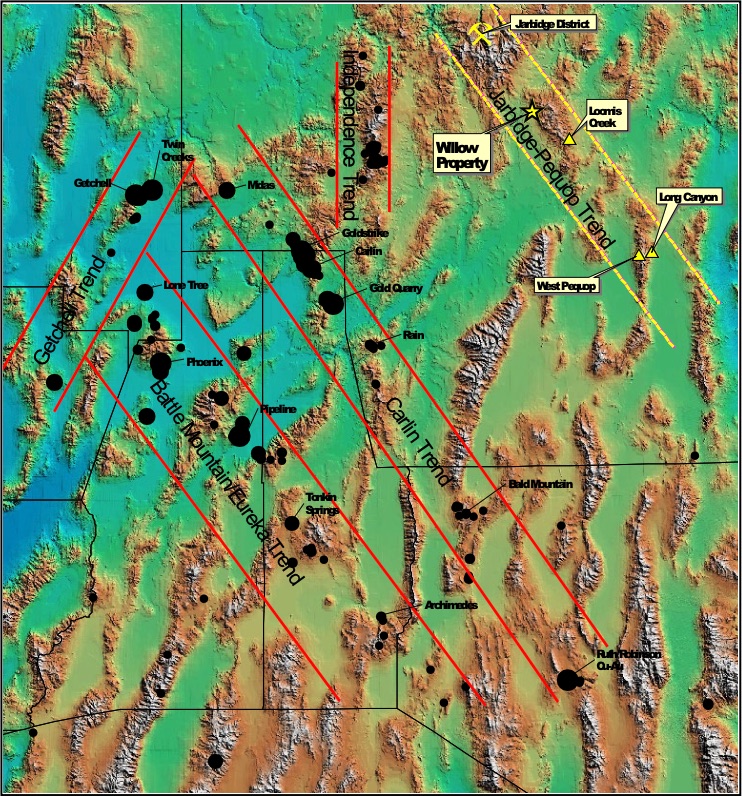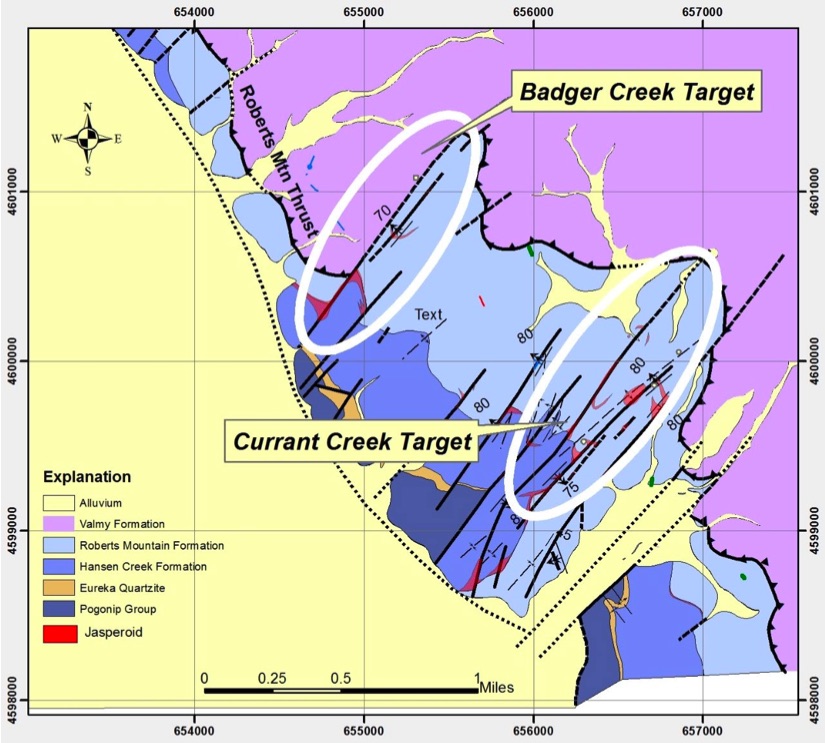TSX:CGD.V
Last:
Volume:
Change:
Date:
Time:
15-20 min delay



The Willow property is located in the northern Snake Mountains approximately 30 miles (48 km) north-northwest of the town of Wells, Nevada. The property lies within an exciting potential new gold belt in northeastern Nevada, which extends from the Jarbidge district to the newly discovered gold deposits at Long Canyon and West Pequop (see Figure 1), and possibly beyond. Willow is approximately 50 miles (80 km) northwest of Long Canyon.
The exploration target is a Carlin-style, disseminated gold deposit hosted in platy silty carbonate rocks of the Roberts Mountains Formation and similar lithologies in the Hanson Creek Formation. Two specific target areas have been identified for drilling: north of Currant Creek, and the Badger Creek area. Rock chip sampling has encountered gold values up to 368 ppb at Currant Creek, and up to 159 ppb at Badger Creek. Jasperoid and anomalous gold at Currant and Badger Creeks are associated with NE-trending structures. Carlin-type trace element geochemistry in rock samples includes elevated As (up to 1560 ppm), Sb (up to 176 ppm), Hg (up to 11.75 ppm) and Tl (up to 20 ppm).
The property consists of 24 QA-claims and 23 CC-claims along the western rangefront of the Snake Mountains. The claims are 100% owned, subject to variable net returns royalties. The area was identified as prospective for Carlin-type gold deposits by Carlin Gold geologists as part of a GIS-based spatial analysis of regional public domain stream sediment geochemical datasets.
The predominant structural feature on the property is the regionally important Roberts Mountain Thrust (RMT, see Figure 2). The RMT trends northwest and lies sub-parallel to the western rangefront of the Snake Mountains. Exposed eastern assemblage (“Lower Plate”) rocks below the RMT include favorable lithologies of the Roberts Mountains and Hanson Creek Formations, as well as the Eureka Quartzite and uppermost dolomite of the Pogonip Group. Western assemblage (“Upper Plate”) rocks above the RMT include siliciclastic rocks and greenstones assigned to the Valmy Formation. Altered intrusive rocks have been recognized at three locations including a felsic dike at Willow Creek just north of the property, and intermediate to mafic dikes within and north of Currant Creek. Zircons extracted from the Willow Creek dike have yielded a U/Pb isotopic age date of 42 Ma, indicating a late-Eocene age of emplacement. This is significant because most of the major Carlin-type deposits in the Great Basin have a temporal association with late-Eocene magmatism.
The sedimentary rock units and the RMT are cut by series of property-scale, NE-trending, high-angle faults, which define the prominent NE-SW drainage geometry of the west flank of the range. Hydrothermal alteration associated with the NE-trending structures includes decalcification and silicification in the carbonate rocks. Intense silicification (jasperoid) is structurally controlled by NE-trending faults, and locally bleeds out laterally along favorable stratigraphic intervals adjacent to the faults. Weak but widespread decalcification and passive silicification is present in the Roberts Mountains Fm. throughout the property. Sericite (illite?)-pyrite alteration is common in the intrusive rocks. Post-mineral movement on some NE faults has offset jasperoid bodies. Upper Plate rocks are relatively unaltered above the RMT adjacent to altered carbonate rocks.
 Figure 1. Digital elevation map of northeastern Nevada showing gold deposits and trends.
Figure 1. Digital elevation map of northeastern Nevada showing gold deposits and trends.
The property has received only a modest amount of past exploration, mostly in the early 1980s. The Currant Creek target area was partially and inadequately tested with two holes in 2008. There were no significant gold values in these holes, but the primary target at Currant Creek remains untested. Additional untested targets also exist, including the Badger Creek target area. Road-cut sampling at the Currant Creek target completed after the limited drilling encountered anomalous gold and a strong arsenic and thallium anomaly within the Roberts Mountain Formation. This anomaly has not been tested, and combined with the identification of additional untested targets, makes the Willow Property a high quality exploration opportunity within an exciting potential new sediment-hosted gold belt. Carlin Gold is seeking a joint venture partner for the property.

Figure 2. Generalized geologic map of the Willow property.